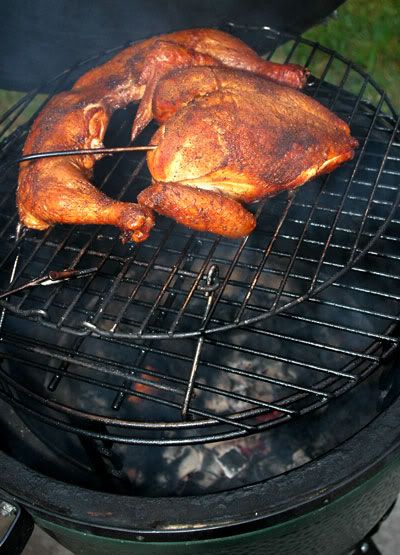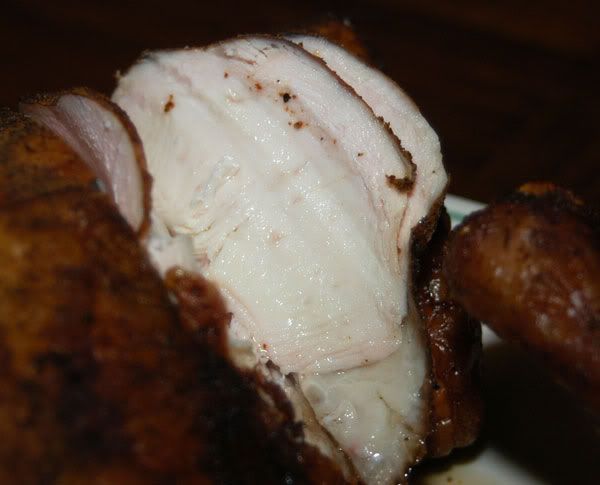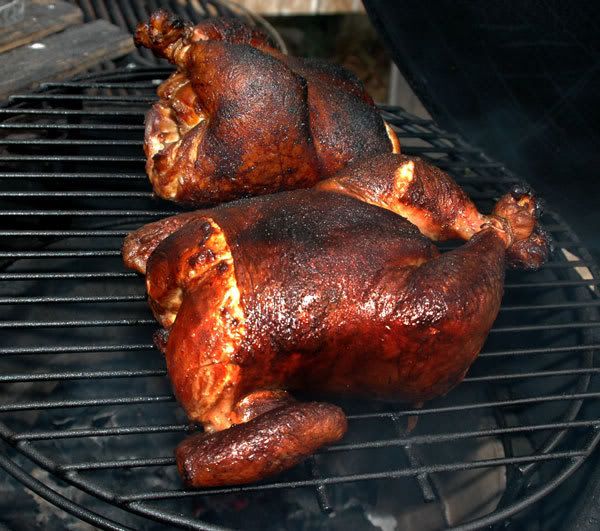Welcome to the EGGhead Forum - a great place to visit and packed with tips and EGGspert advice! You can also join the conversation and get more information and amazing kamado recipes by following Big Green Egg to Experience our World of Flavor™ at:
Want to see how the EGG is made? Click to Watch
Facebook | Twitter | Instagram | Pinterest | Youtube | Vimeo
Share your photos by tagging us and using the hashtag #BigGreenEgg.
Share your photos by tagging us and using the hashtag #BigGreenEgg.
Want to see how the EGG is made? Click to Watch
Direct or Indirect
Options

Mark0525
Posts: 1,235
OK here is a stupid question...what is the difference between indirect or direct cooking? When do you one over the other and how. Don't yell at me...lol
Comments
-
direct is your standard grill, food over fire. inderect is more like an oven, there is a barrier between the food and fire. any barrier can be used, platesetter, pizza stone, fire bricks, metal pan, tinfoil etc for setting up indirectfukahwee maineyou can lead a fish to water but you can not make him drink it
-
direct = nothing (besides the cooking grate) between your fire and your food
indirect = there is something to deflect the heat so it cooks almost like a convection oven
If you want to cook something really slowly (e.g. a pork butt, brisket, etc.) at a low temp, you could put something like a platesetter between your fire and your grate holding the food... google it if you don't know what one is) which heats up and deflects the heat around the food.
On the other hand, if you were cooking a steak (hot and fast), indirect would not make sense, so you'd go direct.
There are some foods that fall into the either/or category based on personal preference (e.g. chicken pieces, pork loins, etc.)
Hope that helps. -
This helps a lot!!! It makes sense. So is the platesetter large enough to cover the lump charcoal? Just by looking at the pictures I thought it was pretty small. Thanks again
-
The platesetter leaves a gap of about 3 inches (guesstimate) all the way around between its edge and the edge of the egg. This allows the air to convect up and around. You don't want to totally block the heat, just make it take a path around the inner walls of the egg.
-
There is nothing preventing one from cooking lo/slo direct.
-
For the last while I have been cooking direct on most all cooks. I use a raised grid and low lump levels for the cook.
If I do a cook where I need a lot of lump then I cook indirect. The only time is use a ceramic barrier, plate setter or pizza stone and or both, is when I do an overnight cook or pizza.
Here is a picture where I wanted to cook chicken at a very low temperature, I wanted a long slow cook. Direct with very raised grid. 16.5" between the lump and grid.

Here is a chicken cooked at 500° direct.
The breast and thighs were just as moist as the picture above.
GG -
heres a butt cooked low and slow direct. with ribs its my prefered method to cook direct infact

direct cooks burn less lump, you just need to cook at a little lower temp and maybe alter your setup a little, and you need to watch things a little more closely, or you could just go fish in a hurricane while cooking your butt :laugh:
http://www.eggheadforum.com/index.php?option=com_simpleboard&func=view&id=507801&catid=1fukahwee maineyou can lead a fish to water but you can not make him drink it -
Do you basically set the heat and put a thermometer in the chicken and just let it alone and not look at it or turn it? I tend to play with my food when I cook it.
-
Remember the BGE is like an oven...every time you open the BGE the temp drops...when the temp drops you are not cooking at proper temps...break yourself of playing with the food. You do not need to do that with an Egg....set it & forget it.


-
Referencing the Weber Kettle grill, we would place the briquettes on the edges and place a drip pan between the two piles to create two heat zones. The heat flows directly from the briquettes out the top of your grill lid. If you were to evenly scatter the briquettes on the bottom of the Weber and place a large piece of meat (chicken, large roast), you'd end up cooking the first layer of meat and would not be able to cook the inner portion. In order to cook a large cut, we cook the meat by warming the entire grill rather than placing a heat source immediately beneath the meat.
With the BGE, this gets a little more complicated because we cannot simply divide the cooking area into zones as we could on the Weber. People often use plate setters to create a physical buffer between the heat and food. As noted above, people have also used a direct heat source with a raised grid in order to elevate the meat from the heat source. -
You can slow cook a large cut of meat at non elevated/reg grid level on a BGE, with great results.
-
Bacchus wrote:There is nothing preventing one from cooking lo/slo direct.
Never said otherwise. My definition of an indirect cook was given in the top line.
Of course, low and slow cooks are neither a subset nor a superset of indirect cooks. I was just giving a possible example of an indirect cook. -
Wasn't suggesting that you did. Just pointing something out is all.
-
Just realized I had a wrong picture above - fixed now.
I have found out with chicken, whole or spatchcocked, it is very simple to cook anywhere from 225° to 500° indirect. For me the cook time ranges from, on the low end 1.5 to 2 hrs to 50 minutes on the high end.
If I cook below 430° dome, at times, I will use the Maverick ET-73 until the bird temp gets close to done, then I verify with the thermapen.
Cooking at higher temperatures I go check at 45 minutes and then 'guess' until the next check time.
GG -
Very true.
I most always refer to raised grid as I use the Adjustable Rig on 99.5% of my cooks. I just like cooking up higher in the dome, maybe it is just habit now.
Normal grid height is fine and cooks great. I cook chicken parts on the mini at normal grid height all the time and the lump distance to grid is much less than in any of my other eggs.
GG -
With the BGE, this gets a little more complicated because we cannot simply divide the cooking area into zones as we could on the Weber.
The need to compartmentalize your fire seems complicated to me. I think that cooking with the Egg is less of a "project" than cooking on a kettle or a WSM. I talk to friends who use those and they freely admit that it's a more labor intensive process than the Egg- but they're used to it.
I tend to go indirect for anything I would roast or bake in the oven or for low and slo's. I know you can cook low and slow direct, but I just haven't tried it. I like to "set it and forget it". -
What can I use if I can't get a platesetter by the weekend? I want to try some chicken cooked indirect and should I raise the grate higher and if so what should I use to raise it? This is fun, I can't wait to cook on it this week and break it in.
-
You just need something below the chicken to deflect the radiative heat from the fire. This can be as simple as an aluminum drip pan. But you might wind up with the drippings from the chicken burning in the drip pan (which is now absorbing a lot of that direct heat), and imparting an unpleasant (to some people) taste. If you're concerned about that, get two drip pans, put one inside the other, with a few balls of aluminum foil keeping them separated.
Personally, I'd just cook the chicken direct...but then, that's how I normally do my chicken anyway. -
I got an 18" Weber replacement grid (available at your local hardware store), (3) 4" carriage bolts with (3) washers and (3) nuts on each. You want to have (3) legs so it'll never wobble. this is what mine looked like before I used it.

This was my raised grid and for indirect cooks I used this with a drip pan beneath it to deflect the heat. (before I got my platesetter)
Firebricks (splits-the half-bricks) are excellent for a barrier or to use to hold up the 2nd grid as a raised grid.
For indirect cooks on my mini, I have a raised grid under which I slip a piece of aluminum foil and that's it!
have fun! -
don't forget that if the food can see the heat source, whether it is off to the side or not, then there is some direct cooking taking place. with an 18"weber, an "indirect" cook means a maximum of half the grid is useable. and even then, the edge facing the fire is still fairly direct.
not trying to bash the weber, just being clear that the differences are even greater. suddenly, it doesn;t seem so complicated inthe bge, especially when you get to use the entire grid.
an indirect set-up in the bge is truly indirect, and uses only air temp (well, plus maybe radiant heat from the dome) to cook.
Categories
- All Categories
- 182.7K EggHead Forum
- 15.7K Forum List
- 459 EGGtoberfest
- 1.9K Forum Feedback
- 10.3K Off Topic
- 2.2K EGG Table Forum
- 1 Rules & Disclaimer
- 9K Cookbook
- 12 Valentines Day
- 91 Holiday Recipes
- 223 Appetizers
- 516 Baking
- 2.4K Beef
- 88 Desserts
- 163 Lamb
- 2.4K Pork
- 1.5K Poultry
- 30 Salads and Dressings
- 320 Sauces, Rubs, Marinades
- 543 Seafood
- 175 Sides
- 121 Soups, Stews, Chilis
- 35 Vegetarian
- 100 Vegetables
- 313 Health
- 293 Weight Loss Forum
